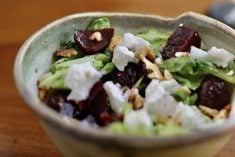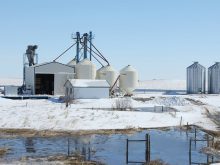It has been refreshing to get out and experience spring. My children love to go out on adventures. This spring that included finding and counting purple prairie crocuses. These gems, along with pussy willows, are the real sign that spring is here. Why do we count them you ask? There is some old folklore in the family that says the more crocuses there are, the better the crop year. We did find a side hill with quite a few, but autumn will confirm the tale.
Do you have folklore like this in your family? Grandparents love passing on these stories. If you want to share their stories, send them and your name and address by June 14, and you could win a copy of Company’s Coming new Most Loved Main Courses or ATCO Gas, Blue Flame Kitchen’s Romancing the Flames for your collection. Here is a sample from the Company’s Coming book:
Read Also

Communication key to bridging generation gap
Each generation is shaped by the predominant forces at play during their formative years. Acknowledging these influences can improve communication among the generations.
Bev’s chicken casserole
This recipe is best served over rice or mashed potatoes. And, of course, add some greens and your meal is complete.
3 pounds bone-in chicken 1.5 kg
parts, skin removed
3/4 teaspoon garlic powder 3 mL
1 teaspoon salt 5 mL
1/4 teaspoon pepper 1 mL
1 can (10 oz.) condensed 284 mL
tomato soup
1 can (10 oz.) condensed 284 mL
cream of mushroom soup
7-9 green onions, thinly sliced
1 small onion, chopped
1 medium tomato
Arrange chicken in a single layer in an ungreased three quart (three L) casserole or small roaster. Sprinkle with garlic, salt and pepper. Combine remaining five ingredients in a medium bowl. Spoon over chicken. Cover. Bake in 350 F (180 C) oven for about two hours or until tender. Serves four to six people.
Baked treats
For dessert after the casserole, try these simple-to-make treats.
Blueberry cake
2 cups all-purpose flour 500 mL
11/2 cups sugar 375 mL
1/2 cup cold butter or margarine 125 mL
1 teaspoon baking powder 5 mL
1 cup milk 250 mL
2 eggs, separated
2 cups fresh or frozen, 500 mL
blueberries
In a mixing bowl, combine flour and sugar. Cut in the butter until crumbly. Set aside 3/4 cup (175 mL) for topping. Add the baking powder, milk and egg yolks to remaining mixture and mix well. Beat egg whites until soft peaks form and fold them into the batter.
Pour into a greased nine by 13 inch (22 x 33 cm) pan. Sprinkle with blueberries and reserved crumb mixture. Bake at 350 F (180 C) for 30-35 minutes. If using frozen berries, do not thaw before using.
Cinnamon rolls
2 cups flour 500 mL
2 tablespoons sugar 30 mL
4 teaspoons baking powder 20 mL
1/4 teaspoon salt 1 mL
1/2 cup margarine or butter 125 mL
1 egg
1/3 cup milk 75 mL
Filling
1 cup brown sugar 250 mL
1/2 cup melted margarine or 125 mL
butter
2 teaspoons cinnamon 10 mL
Preheat oven to 425 F (220 C).
In a mixing bowl, combine the flour, sugar, baking powder and salt. Cut in first amount of butter. In another bowl combine the egg and milk. Add mixture. Combine until the dough feels workable and moist. Roll flat.
Mix the brown sugar, margarine or butter and cinnamon. Spread over rolled dough. Roll, seal seams and slice into one inch (2.5 cm) pieces. Place in either a greased nine by13 inch (22 x 33 cm) pan or individually into muffin tins and bake for 20 minutes.
Sports drinks
Dear TEAM: Each time my family goes to the sports centre for an event or to a convenience store they want to buy the highly marketed and colorful sports drinks. They are expensive. Are they really good for you? – Joanne via the internet.
Dear Joanne: I contacted local nutritionist Sheri Taylor for help with your question.
Sports drinks are designed for athletes who work out continuously and intensely for 60-90 minutes, such as marathon runners. They are formulated to give small amounts of sugar, along with water, that will digest quickly and keep the body going during a workout. Sports drinks can be consumed after a workout, but more concentrated sources of sugar such as fruit juices are better choices at this time. Athletes can make their own sports drinks by diluting orange juice with half water and adding a sprinkle of salt. Another option is to drink water and snack on high carbohydrate foods such as crackers or fruit during a workout. These are cheaper and more nutritious.
There is concern that sports drinks are being consumed by children as a daily beverage. Have you looked at the ingredients of popular sports drinks? Water, sugar, salt, potassium and oil are the main ones. In fact, a 591 mL bottle of a popular sports beverage, contains nine to 13 teaspoons of sugar. This is only slightly less sugar than the same amount of soda pop. The extra sugar and calories from these drinks are not needed if youth are sitting in class all day or participating in activities lasting less than one hour. Water is still one of your best choices.
Here’s a reference guide from CBC’s consumer tips news section to help understand what it all means.
- Mineral and spring water must come from an underground source (not a public water supply) and can’t be changed in any way by chemicals. Mineral water has a higher amount of dissolved mineral salts.
- Bottled water is water from any source that can be distilled or carbonated or treated in any other way. The water in Dasani, owned by Coca-Cola, comes straight out of the tap from municipal supplies.
- Artesian water is bottled water from a well that taps a confined aquifer (a water-bearing underground layer of rock or sand) in which the water level stands at some height above the top of the aquifer.
- Sparkling water has been carbonated. Soda water, seltzer water and tonic water are not considered bottled waters.
- Glacial water is from a source directly from a glacier.
- Natural water such as spring, mineral, artesian or well water is obtained from an approved underground source and not from a municipal or public water supply system. This water has undergone no treatment other than physical filtration and iron removal.
- Purified water is produced by distillation, deionization or reverse osmosis and contains not more than 10 mg/L of dissolved solids.














